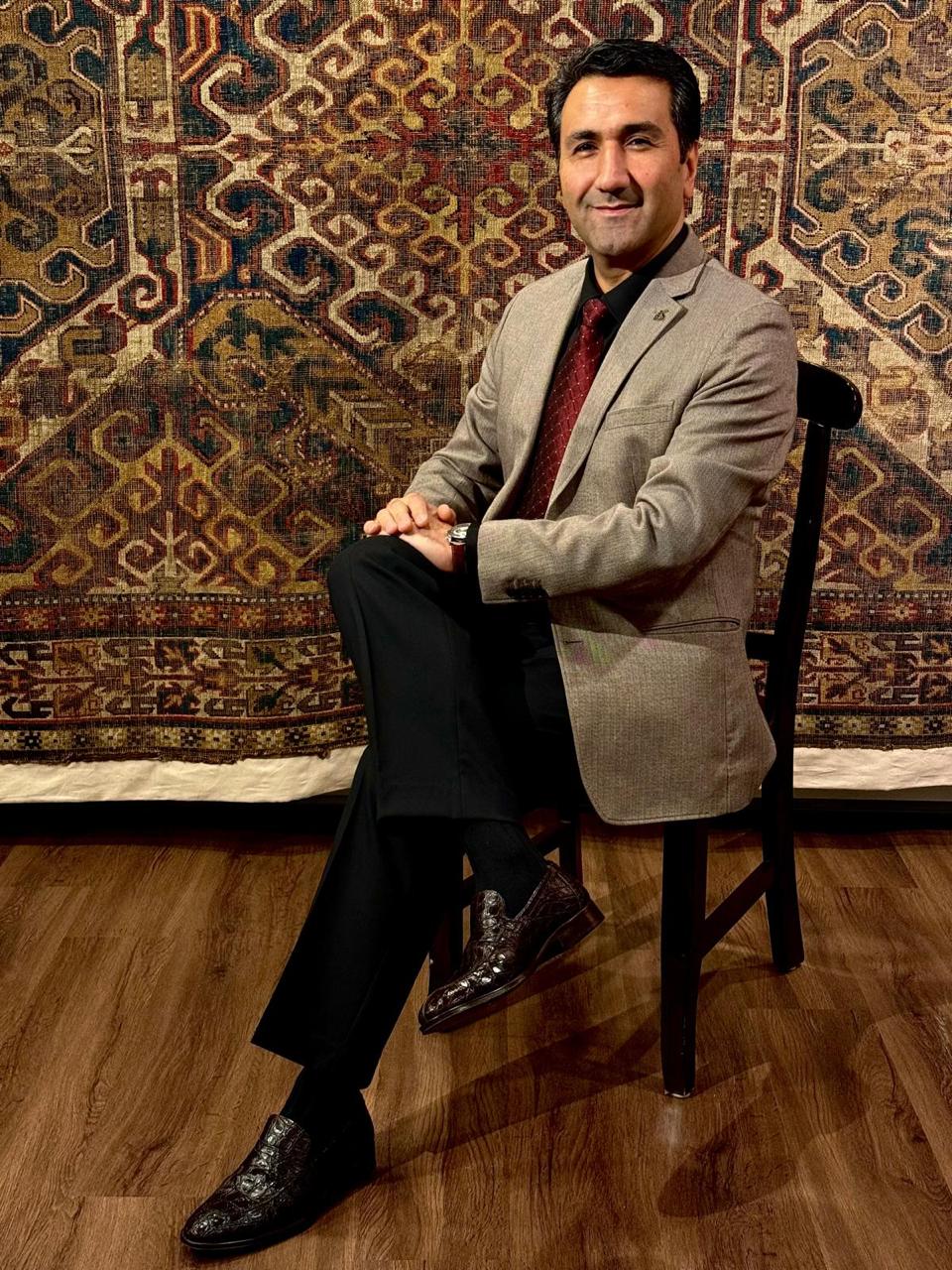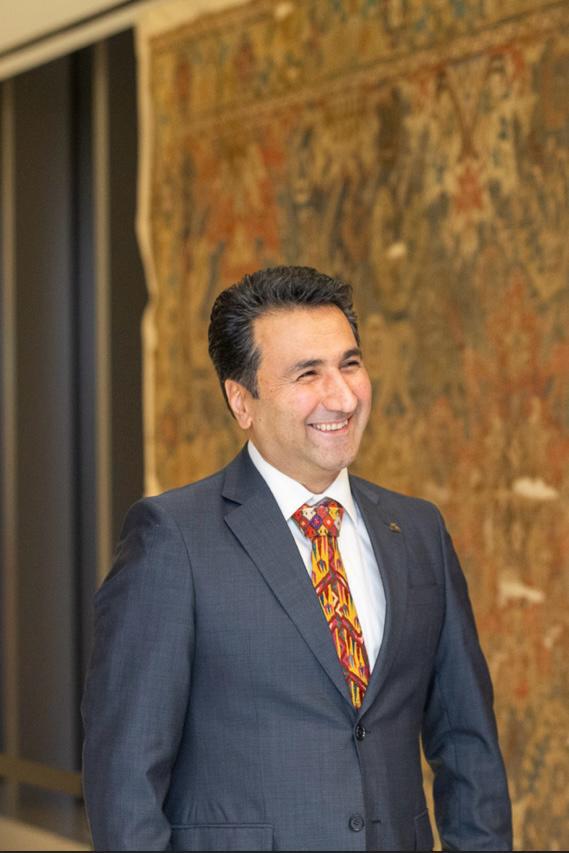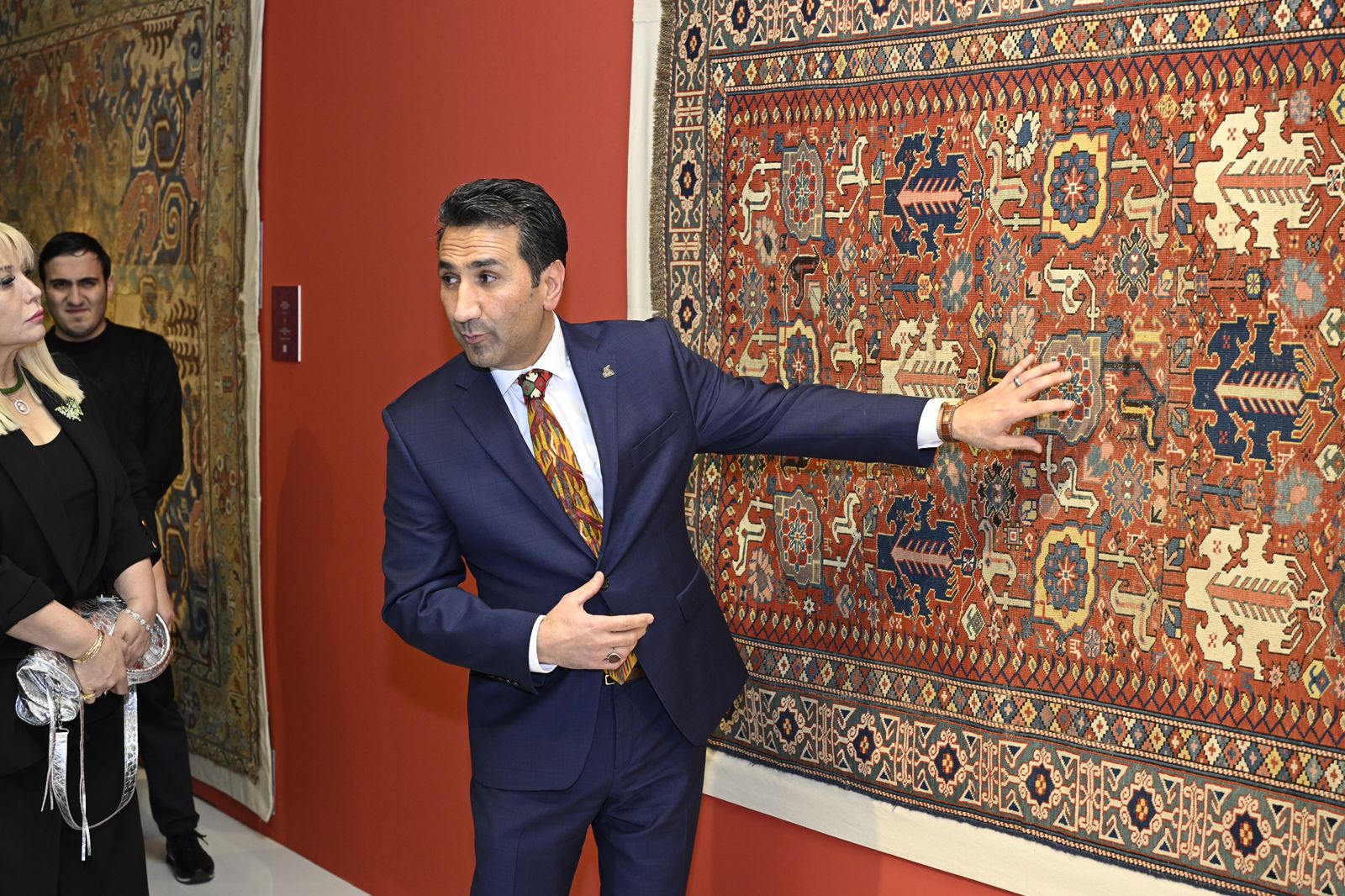The art of carpet weaving is a form of magic, encapsulated in intricate designs. It is an art where every thread becomes part of a grand story, and each knot holds the secret of the craftsman. Carpet weaving is not merely the creation of beautiful items; it is a language through which artisans have shared their culture, traditions, and personal experiences over centuries.
Our interviewee is carpet collector Amir Oskoui. Working in his father’s antique shop, he discovered his love for exquisite carpets and textiles. Later, he became an apprentice to the renowned Tabriz antique carpet dealer, Hasan Akhani.
In 2007, Amir Oskoui moved to the United States and began working for an American company. Over two and a half years, he learned the art of carpet trading and established his own business. In 2018, he decided to start collecting Azerbaijani palace carpets.
Four years later, Amir Oskoui opened his own carpet shop. Initially focusing on selling antique carpets, he later expanded his business to include their restoration. Soon, he assembled a team of restoration specialists and began studying the carpet restoration process himself.
– Mr. Amir, how did you become interested in carpets?
– I have had a connection with carpets since childhood. It was my father’s business, but I can say that I have a special spiritual bond with carpets. As I grew older, I became drawn not only to the carpets themselves but also to their mystery, diversity, and history. I developed a desire to learn more about what else this fascinating world holds.
At a certain point, I decided to continue my journey on my own to explore carpets from other regions and expand my knowledge in this field. This journey is similar to schooling: each year, you move to a new level, learn something new, and with each stage, the complexity increases.
At first, I focused on carpets, and then I became interested in embroidery, fabrics, and kilims. The world of carpets is incredibly vast, and no one can claim to fully understand it. If someone says otherwise, they are simply deceiving themselves. Even I, with my experience, am still in the process of learning. This work is full of surprises. Every day, you encounter such rare and unique pieces that inspire genuine admiration and a desire to study them. The more you learn, the stronger your attachment to this craft becomes. For me, every new secret of a carpet that I uncover gives me incredible energy and inspiration to continue my journey.
– How did you decide to open your own carpet store?
– Opening my own store was a logical step after working for four years with a master who specialized in world-class carpet trading. During these years, I not only mastered the intricacies of the profession but also felt that I was ready to move forward. At some point, I realized it was time to create something of my own. That’s how I opened my store and began my professional journey in the world of carpets.

At first, I focused on semi-antique carpets, but over time, that wasn’t enough. I became attracted to antique carpets, especially Yörüks. This is an entirely unique world, filled with passion, soul, and history. Each piece seems to tell its own story, and this discovery drew me into a new reality. For someone who has always valued spirituality and sought deep meanings, this world became a true inspiration. I felt that I had found my place, and this gave me the inner strength to move forward.
– How important was it for you to work with experts in the restoration of antique carpets? What did this process give you?
– In the American antique carpet market, I encountered the fact that buying and selling such items often requires restoration skills. This prompted me to study the art of restoration. I began collaborating with restoration masters, assembled a team of professionals, and gradually mastered their craft. I realized that to truly understand a carpet, you must study it from the inside out: how it was woven, what materials were used, and what technologies were employed.

Restoration is a meticulous and lengthy process. Some pieces take weeks, and sometimes even months. After completing all stages and the final wash, the carpet is fully restored: it is taken off the floor and used to decorate the walls. This process brings me immense pleasure. As Mevlana said: “We broke off from the stone, fell to the earth, and became soil. A seed fell into the soil, and a sprout grew from it. The sprout was eaten by an animal, the animal by a human, and now we will gain wings and soar.” This idea reflects the process of elevation and transformation, which I see in carpets.
– What is the attitude of people around the world, who are interested in carpet art, toward Azerbaijani carpets?
– Azerbaijani carpets hold enormous value for global collectors. Each of them takes pride in owning an Azerbaijani carpet, as it is not just a work of art; it is a cultural heritage with a deep history and high aesthetic value, deserving of admiration and recognition.
– What, in your opinion, are the main differences between Azerbaijani carpets and other types of carpet art? What traits make them unique?
– Azerbaijani carpets, especially nomadic ones (Yörük), stand out for their unparalleled aesthetics. Unlike carpets from other countries, where you can see clear symmetry or asymmetry, our carpets often lack strict symmetry, and this is what creates their unique beauty. Their uniqueness is also reflected in the color palette: for example, a deep blue can unexpectedly transition to a lighter shade, giving the carpet depth and expressiveness. Another important feature is their quality and durability, which play a key role in making Azerbaijani carpets not only beautiful but also practical.
– Which carpet from your collection do you value the most and why? Could you share with us its historical and spiritual significance?
– When building my collection, I paid attention to reflecting the spirit of the Safavid era, especially elements of Sufism. The artists of that time were not just masters of their craft — many were also doctors and poets. Their works were born from the depths of their souls and were based on the lessons they had learned in the past.

You ask which carpet I value the most? It’s like asking parents which child they love more. Every parent would struggle to answer because they love all their children equally. The same goes for my carpets.
In my collection, I have Tibetan carpets, beautiful examples that I truly appreciate. I also have Chinese carpets from the 16th century, which hold a special place. At that time, China also had a rich carpet culture, and palaces were adorned with magnificent pieces.
However, I always believe that a person should primarily return to their roots. That’s why I focused on collecting Azerbaijani carpets first. And although I trade carpets, I have collections that I will never sell. The collection of Azerbaijani carpets is one of them.
– Carpets are a kind of language, a cipher. What is needed to "read" them?
– To "read" a carpet, you need to understand its symbolism. Symbols are the key to unlocking hidden meanings, and studying them requires time and attention. In my research project, this topic holds a central place, especially in the educational and research aspects. This knowledge must be shared with people because carpets are an inexhaustible source of discoveries. Every time, you can find something new, and many of their secrets remain unsolved.

I’ve always viewed a carpet as a letter from the past. To understand it, one must learn to pay attention to the details. This is especially true for the carpets of nomadic peoples. In them, you can observe mysterious changes: the carpet begins with one pattern, and then suddenly changes. Why? What did the master want to convey? Why did he decide to break the original design?
If you closely examine such carpets, you can notice how the patterns interweave and how different symbols are used. Sometimes the width of the borders narrows, then expands, and then returns to its previous form. These nuances are not accidental. The master always had his reasons, hidden meanings. He could have made the carpet perfectly symmetrical, but consciously added elements that gave it uniqueness, turning it into a message.
Each carpet is a mystery that holds the secrets of its era. To understand it, you need not only knowledge of techniques and materials but also a deep understanding of culture, history, and traditions. Carpets are not just works of art; they are languages that speak to those who are ready to listen.
– Are you planning any new projects within your field of work?
– I have a project that I presented during my last visit to Azerbaijan. I want to create an academy that will bring together the craft arts of Turkic peoples. This will be an educational and research center aimed at preserving, studying, and popularizing traditions. It will also feature a museum, where unique works of art will be collected.
My dream is to turn Azerbaijan into a global center of carpet weaving, where masterpieces from around the world will be gathered. I want people who are seeking genuine knowledge about carpets to come here, enjoy the beauty of Azerbaijani carpets, restore their pieces, and gain accurate knowledge and certificates for their carpets.
I am confident that this project will not only be an important step for preserving cultural heritage but also a significant source of economic growth for current and future generations.













